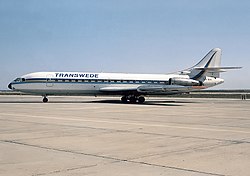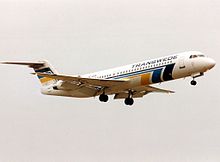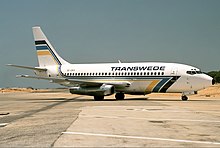Transwede
| Transwede | |
|---|---|

|
|

|
|
| IATA code : | TQ |
| ICAO code : | TWE |
| Call sign : | Transwede |
| Founding: | 1985 |
| Operation stopped: | 1996 |
| Seat: |
Stockholm Sweden |
| Home airport : | Stockholm / Arlanda Airport |
| Fleet size: | 12 |
| Aims: | National and international |
| Transwede ceased operations in 1996. The information in italics refer to the last status before the end of operation. | |
The Transwede was a Swedish airline . The company was split up in 1996 into the airlines Transwede Airways and Transwede Leisure . The charter airline Blue Scandinavia emerged from Transwede Leisure . The scheduled airline Transwede Airways was renamed Braathens Sverige in 1998 . The Braathens Group used the name Transwede Airways again from 2004 to 2010 for a company. This company used its aircraft in wet lease for other airlines.
history
Aerocenter Trafikflyg
The origins of the Transwede go back to the 1970s. In 1975 Thomas Johansson, who later became the owner of Transwede, founded Aerocenter Trafikflyg. The company based in Växjö took up flight operations in the spring of 1976 with a Cessna 172 . In the following year, twin-engine business jets were added to the fleet (including Piper PA-31 , Beechcraft 99 , Cessna 404 and Beechcraft King Air B90 ). In April 1980 and February 1981 the company acquired a Fairchild (Fokker) F-27 each and used these 44-seater transport machines for occasional services within Sweden and on flights to Denmark.
Johansson sold his company to the airline Swedair in the spring of 1983, which at that time mainly carried out on-demand flights on behalf of the coast guard and target display flights for the Swedish military. After the sale, Aerocenter operated as an independent subsidiary of Swedair under the name Swedair i Växjö, AB. In the course of 1983 Swedair Växjö's fleet grew to five Fairchild (Fokker) F-27s , two of which were operated on behalf of Scandinavian Airlines and Linjeflyg , while the fifth aircraft was used for charter flights . At the end of 1984 Thomas Johansson, who continued to work as managing director of Swedair Växjö, signed a leasing contract for the rental of a Sud Aviation Caravelle (LN-BSE). The aircraft was to be used during the 1985 summer season on behalf of a Norwegian travel company. Because of this contract, there were differences of opinion between the Swedair board and Johansson, who then left the company. Swedair i Växjö, AB was then integrated into the parent company.
Foundation of the Transwede

After separating from Swedair, Johansson founded his own airline for the second time in the spring of 1985. This company was initially renamed Aerocenter Trafikflyg again, but was renamed Transwede a short time later. Transwede took over the leased Caravelle on March 6, 1985 . The aircraft was first used on March 31, 1985 on a charter flight from Haugesund via Stavanger to Palma de Mallorca . In November and December 1985, the company received another Caravelle 10B each and used these 109-seater machines on charter flights from Stockholm to the Mediterranean. At the same time, contracts for the maintenance of the aircraft were concluded with Finnair . At the beginning of 1986 two Caravelle 10Rs from Hispania's stock added to the fleet. In the summer of 1986, the company was able to acquire and further expand an important customer in the form of the Swedish travel company Fritidsresor . With the delivery of the first McDonnell Douglas MD-83 from September 1986, Transwede had an aircraft that had the necessary range for direct flights to the important winter destinations in the Canary Islands. From August 1988, the shorter MD-87 , another type from the MD-80 family, was used. Transwede used the MD-87, among other things, on long-haul flights from Stockholm to Fort Lauderdale , with the aircraft stopping in Gander (partly also in Keflavik ) and being refueled. Miami and Barbados were added as further transatlantic destinations from 1989. At the beginning of 1989 the last two Caravelle aircraft were decommissioned and replaced by two leased Boeing 737-200s that had previously been in service with the Norwegian airline Braathens . The first machine (SE-DKG) was handed over in March 1989. This aircraft was also the first Boeing 737 that ever received a Swedish registration. In the same year Transwede took a majority stake in the newly founded Turkish Sultan Air and leased its decommissioned Carvarelle to the company. The effects of the Second Gulf War led to a recession in the tourism sector in 1990, which particularly affected the Turkish market. The Transwede then sold its shares in the Turkish company in October 1990. At the same time, the company's founder Thomas Johansson left the company and moved to the board of directors of Sultan Air.
Recording of scheduled flights

As early as December 1988, Transwede had applied for scheduled flight rights for the domestic routes from Gothenburg to Luleå and Sundsvall , but did not receive them from the Swedish government. After the liberalization of Swedish air traffic, the company operated its first scheduled flight on March 14, 1991 on the Stockholm - London-Gatwick route . From July 1, 1992, Transwede also flew scheduled services within Sweden, making the company a direct competitor of Scandinavian Airlines and Linjeflyg . Initially, the national route network only included the cities of Gothenburg, Luleå and Umeå . At the beginning of 1993 Halmstad and Malmö were added as additional destinations. The existing aircraft of the MD-80 series turned out to be clearly too big on these routes. Their low occupancy made cost-covering flight operations impossible and caused losses of 266 million kronor by the end of 1992. In the spring, smaller Fokker F-100 machines were ordered, which were used on national routes from August 1993. Despite the new aircraft, the airline continued to operate in deficit. At the end of 1993 the losses amounted to 294 million crowns. One of the main reasons was the sharp rise in personnel costs. As a result of the numerous new routes and the expansion of the fleet, the number of employees had increased by almost 40 percent to around 800 within a year. Because of the ongoing losses, around 200 employees were laid off in mid-1995 and three aircraft were returned to the lessor. Attempts were made to increase the profitability of the charter sector by using larger Boeing 757 aircraft , which from December 1995 supplemented the fleet and were designed for 223 passengers in the chosen configuration.
restructuring
At the beginning of 1996 the Transwede was reorganized and split into two independent airlines. The charter flight division became Transwede Leisure AB, while the scheduled flight division was named Transwede Airways AB. The parent company Transpool was the owner of the two companies.
Transwede Airways
In September 1996 the Norwegian airline Braathens acquired a 50 percent stake in the scheduled flight subsidiary Transwede Airways, whose fleet at that time consisted of five Fokker 100s . As a supplement, leased Boeing 737-300s were used from May 1997 . In the first year of its existence, the company carried around 700,000 passengers. In March 1998 Braathens acquired the remaining company shares and became the sole owner of Transwede Airways. On April 1, 1998, the company was renamed Braathens Sverige AB. In the same year, Braathens acquired another Swedish airline, Malmö Aviation . The two airlines merged at the end of 1998 to form Braathens Malmö Aviation. In 2000 the airline was renamed Malmö Aviation again. From 2004 to March 2010, the Braathens Group used the name Transwede Airways for a company that operated its aircraft on what is known as wet lease for European airlines. These flights were carried out under the name and flight number of the respective customer.
Transwede Leisure
The Transwede Leisure was taken over in 1996 by the Swedish tour operator Fritidsresor , who renamed the company on October 28, 1996 in Blue Scandinavia . In December 1997, Fritidsresor and Blue Scandinavia were bought by the British travel group Thomson Travel. With Britannia Airways, the Thomson Group already owned a renowned charter airline and integrated Blue Scandinavia under the name Britannia Airways, AB into the group. TUIfly Nordic emerged from the Swedish Britannia Airways in 2005 .
IATA and ICAO codes
An overview of the IATA and ICAO codes and call signs used by the various companies up to 1998 (if known):
| Period | Companies | IATA code | ICAO code | Callsign |
|---|---|---|---|---|
| before 1980 | Aerocenter Trafikflyg | (without) | (without) | - |
| 1980 to 1982 | Aerocenter Trafikflyg | (without) | GM | - |
| 1983 to 1985 | Swedair i Vaxjö | (without) | GM | Swedair |
| 1985 | Transwede | (without) | GM | Transwede |
| 1986 to 1989 | Transwede | TQ | GMP | Transwede |
| 1990 to 1996 | Transwede | TQ | TWE | Transwede |
| 1996 | Transwede Airways | TQ | TQA | Victory |
| 1996 | Transwede Leisure | (without) | TWE | Transwede |
| 1996 to 1998 | Blue Scandinavia | 6B | BLX | Bluescan |
| 1997 to 1998 | Transwede Airways | TQ | TQA | Swedair |
fleet

- Boeing 737-200 and 737-300
- Boeing 757-200
- Fokker F-100
- McDonnell Douglas MD-83 and MD-87
- Lockheed L-1011 (Transwede Leisure only)
- Sud Aviation Caravelle 10B and 10R
incident
On January 6, 1987, a Sud Aviation Caravelle (SE-DEC) had an accident while taking off from Stockholm / Arlanda Airport . Due to the formation of ice on the wings, the machine bounced back onto the runway immediately after take-off, with the nose landing gear breaking. The aircraft was written off as a total loss. The 27 inmates were uninjured.